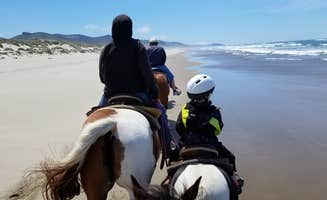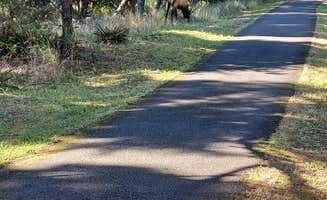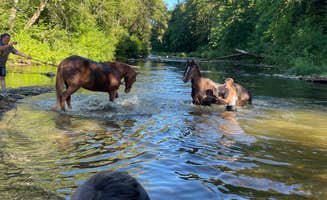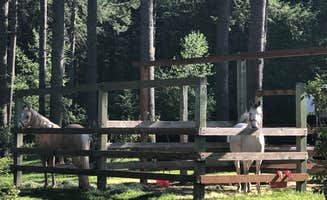Equestrian campgrounds near Cannon Beach, Oregon provide access to forest trails and coastal riding experiences. L.L. Stub Stewart Memorial State Park and Clatsop State Forest both offer dedicated horse campsites with amenities designed for equestrian travelers. Trail networks range from gently sloping forest roads to steeper terrain requiring experienced riders.
What to do
Beachcomb and fish at Fort Stevens State Park: Located 20 miles north of Cannon Beach, this large campground offers diverse recreation options. One camper noted, "Such a great place to stay on the Oregon coast! I love this campground because it's on the coast, very beautiful and spacious. Great sites around to see including the mouth of the Columbia River." The park features the historic Peter Iredale shipwreck, accessible at low tide.
Visit the maritime museum: Fort Stevens offers proximity to regional attractions. "There is sooo much to do in this area! It's rich with history and we could have easily spent another week touring around. The Maritime Museum is up the road," reports one visitor. The museum provides context for the Columbia River's maritime importance and dangerous navigation history.
Camp and ride at Hares Canyon Horse Camp: Smaller than Clatsop's Northrup Creek facility, Hares Canyon offers full hookups specifically for equestrians. "Experiencing several of the many long trails on horseback was an unforgettable experience. The horse camp comes complete with full hookups, a full bathroom with showers, and corrals for the horses," notes one camper. Rangers regularly patrol to ensure horses occupy each site.
What campers like
Water recreation options: Nehalem Bay State Park provides both ocean beach and protected bay access. "Nehalem Bay is beautiful, and it's just down the road from two jetties. My family and I went crabbing just a ways away from the state park, and it was a beautiful day and a lot of fun," reports one visitor. Crabbing equipment rentals available seasonally in nearby towns.
Separation from crowds: Snag Lake Campground offers more secluded camping across the Columbia River in Washington. "Primitive, private campsites around a beautiful small lake. Only 2 camp sites are drive-in, rest are walk-in only so be prepared to haul in all of your gear," explains one camper. The lake contains numerous fallen trees creating habitat for stocked trout.
Trail networks: Equestrian trails at Camp Wilkerson accommodate riders looking for alternatives to coastal routes. One camper reports, "Stayed the night in one of their small cabins, very nice sat outside by the fire and just watched the stars, this is a primary horse camp and is surrounded by trails, seen a heard of elk on one of my hikes." The camp includes both horseback and hiking trails through forested terrain.
What you should know
Seasonal conditions matter: Late summer offers optimal riding conditions. "Oregon is well known for its magnificent state parks, and this is no exception. Unfortunately in May, the mosquitos were out in full force in the campground," reports a Fort Stevens camper. Spring and fall bring consistent rainfall that can create muddy trail conditions.
Trail maintenance varies: Smaller horse campgrounds may have less trail upkeep. "Mixedfeeling about this place, the trails are great however owners don't clean up after there horses that go on the trail," notes one L.L. Stub Stewart visitor. Carrying basic trail maintenance tools helps navigate occasional fallen branches.
Reservation requirements differ: Jones Creek Campground operates differently than reservation-based horse camps. "I showed up around 3pm on a Friday and was barely able to find a walk-in tent site. All the car-accessible sites were taken and the only reservable site is the group spot," explains one camper. First-come availability means mid-week arrival improves chances of securing desired sites.
Tips for camping with families
Choose beach-access campgrounds: Nehalem Bay State Park offers family-friendly camping with easy beach access. "We love this camp ground just the perfect little spot to have a base camp and explore the Oregon coast! Spots are nice pretty private as far as distance but there could be more trees between. It's the beach!" explains one visitor. Sites in loops closer to the beach tend to fill faster.
Explore historical features: Fort Stevens includes military history that interests children. "We brought the kids and expected to listen to their complaints the whole time, but they were intrigued by everything!" reports one family. The concrete gun batteries and interpretive displays provide educational opportunities.
Consider hike-in camping: Dairy Creek East at L.L. Stub Stewart State Park offers features for families not wanting to camp with horses. "Open feel, but sites are spacious. Nice playground for kids, fun disc golf course and wonderful access to biking (paved or dirt)," explains a visitor. The paved Banks-Vernonia trail accommodates family cycling through the forest.
Tips from RVers
Understand site configurations: L.L. Stub Stewart Memorial State Park provides different RV experiences between campgrounds. "Our spot was very spacious as the length was 45 feet deep on asphalt. It had a picnic table and a fire ring in a well-groomed gravel area about 30' x 30'. The back of our spot was against very high trees," notes one RVer staying at Dairy Creek East. Sites below number 40 typically offer more shade.
Check seasonal closures: Northrup Creek Horse Campground in Clatsop State Forest closes seasonally unlike some coastal campgrounds. "This is a wonderful campground far enough off the beaten path and being listed has a horse camp most likely keeps the crowds down. While this is a horse campground, only 8 of the sites are for horse campers, a small tent/RV camping loop of 3 sites is also available," explains one visitor. The campground typically opens May 1 depending on road conditions.





